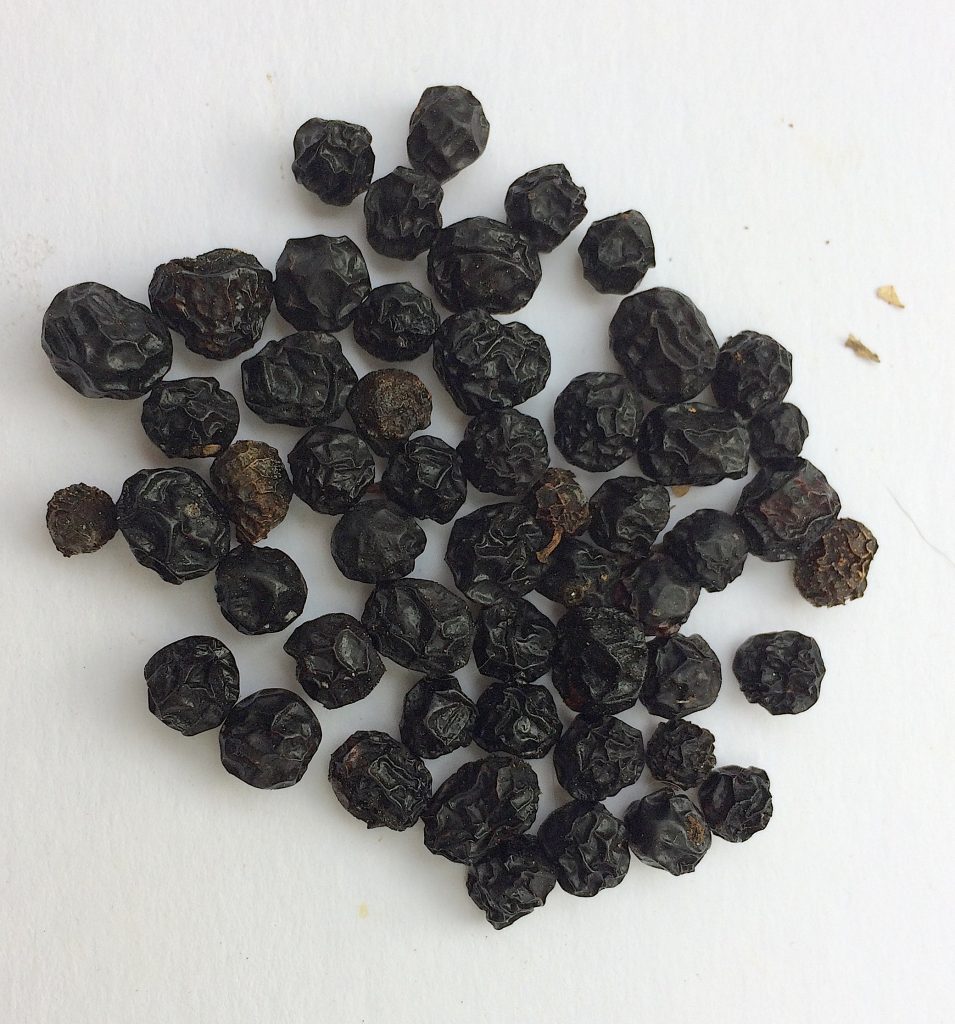
Most foragers know that Smilax tips are edible. Some consider them the best springtime green of the year. Young roots have been eaten for a long time. The starch in older roots has been used to make a false beer and might have some anti-cancer property. Many foraging books say the berries make a good “gum” substitute. That is nonsense and tells me the writer never tried them. It can take up 18 months for the green berries to ripen to black. They are astringent nearly every day of the way. Even when black and looking like raisins they are marginally edible. I was asked during a recent foraging class if the berries were edible if picked while ripe then dehydrated. I had no answer so I picked some and air dried them until they were shriveled. They were soft like raisons (save for the seeds) and edible, even slightly sweet. Still not like gum. Now when I find plump black Smilax fruit I take them home for dehyrdating. Incidentally, another fruit species that improves greatly by dehydrating is Dove Plum. You can read about it here.
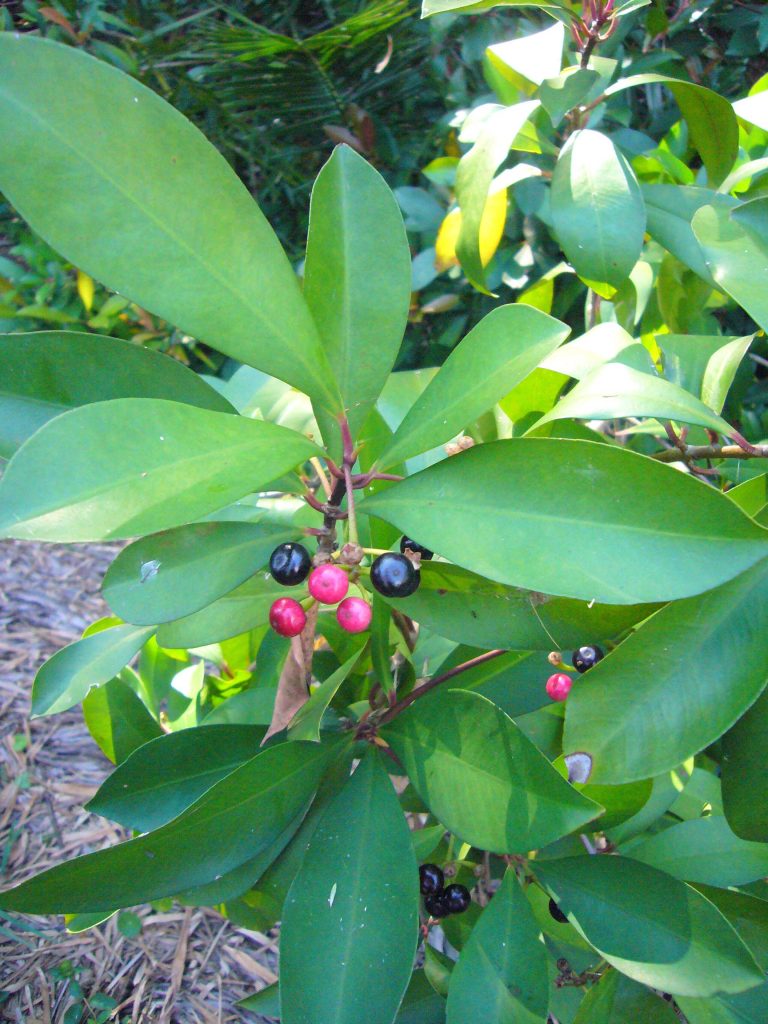
Marlberries and I don’t meet too often, about once or twice a year and then usually while I am conducting a class so I don’t have the time to get acquainted better. It’s just not an edible I have “inside” my head yet. There is also a certain lack of motivation because even at its best Marlberry is not a great trailside nibble. A complicating headache is there are several malberries of varying quality. We saw a probable Marlberry this past weekend during a class at George LaStrange Preserve near Ft. Pierce. By the time I saw it second time there (which unlike the first time had red berries turning to black) my memory suggest Marlberry.
Reportedly found mid-Florida and south I have only seen them in coastal areas such as Ft. Pierce and West Palm Beach on the east coast and near Sarasota on the west coast. The season can vary quite a bit between the coasts as well, as much as two months. Around the same time and in the same habitat you can also see Rapanea punctata, one of those mystery pants one finds in the woods this time of year. It looks like a drab cross between a mangrove and a beautyberry. The fruit grows on the stem. There’s not a whole lot of literature on it so the berries are probably not edible. To read more about the Marlberry and its strange relative go here.
Now is the time for my semi-annual rant about time change. I will freely admit I do not like the time change and that I ignore it. For twelve years I have refused to “spring forward” or in autumn “fall back.” I stay on standard time or what I call solar time. I do not change my clocks, my eating habits, my animals’ eating habits or my bed time. Why? Time change puts me out of sorts for weeks if not months. (I have the same long-term problem with travel. When I lived in Japan it took me nearly two months to get used to the 13-hour difference. When I go to Greece I have to stay for at least four weeks.) For the next several months I just have to remember that when I need to interact with the outside world it thinks it’s an hour ahead of me. Florida voted last year to stay on Daylight Saving Time permanently. It was an action that was not well-thought out. DST is a federal program. Thus you need federal approval to stay on DST permanently. Our dysfunctional Congress has no political reason to approve that. If Florida had voted to stay on standard time no federal approval was or is needed. The seasonal flip-flopping is so irritating I have written two articles about it. One is Daylight Slaving Time and the other is It’s About Time.
Thistle Epistle: Sorting out true thistles for food is on par with identifying true pines and oaks. If it is a Quercus the acorns are edible (after necessary leaching.) The particular species is usually not relevant. If it is a Pinus that pine tree has parts you can eat. Again the particular species is usually not relevant. All Cirsiums — true thistles — are edible though the flavor and texture will vary from species to species. Thus telling true thistles from each other is matter of form than necessity but here is how to tell a couple of common ones apart:
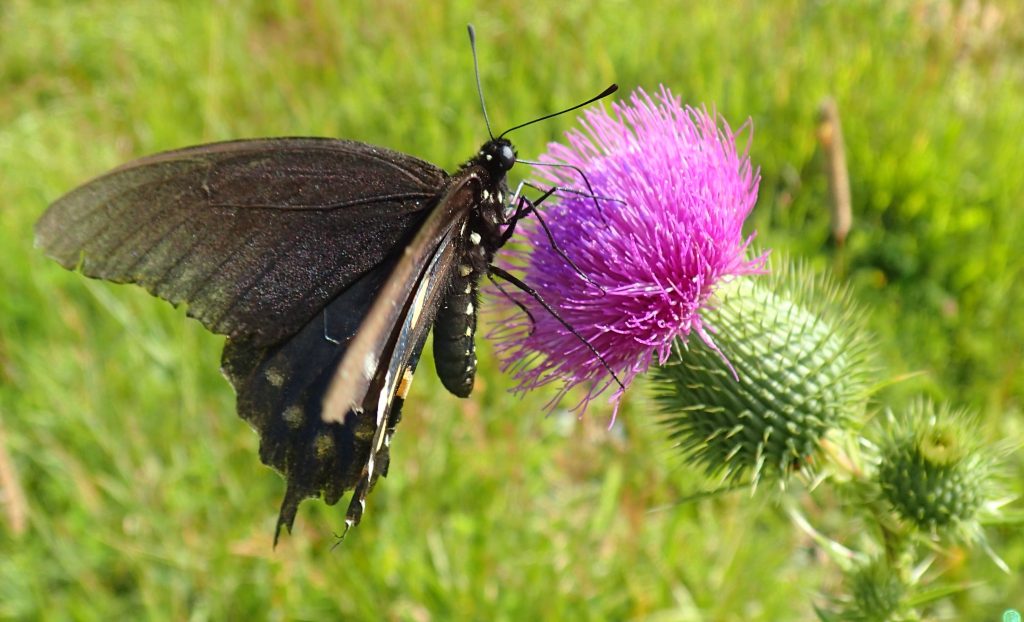
Cirsium nuttallii: Nuttall’s Thistle grows from eight inches to eleven feet tall though half that height is most common. It ranges state-wide but I see it more often in the western side of the state. The small blossoms can be white, pink, purple or violet. It also can have many blossoms at the same time unlike the thistle below. It has one main stem, with many or few branches, ascending. Leaves are narrow to broadly elliptic, deeply lobed. This member of the sunflower family has fleshy, creeping roots which like all true thistles are edible raw or cooked. It likes roadsides ditches, and woodlands, often damp soil.
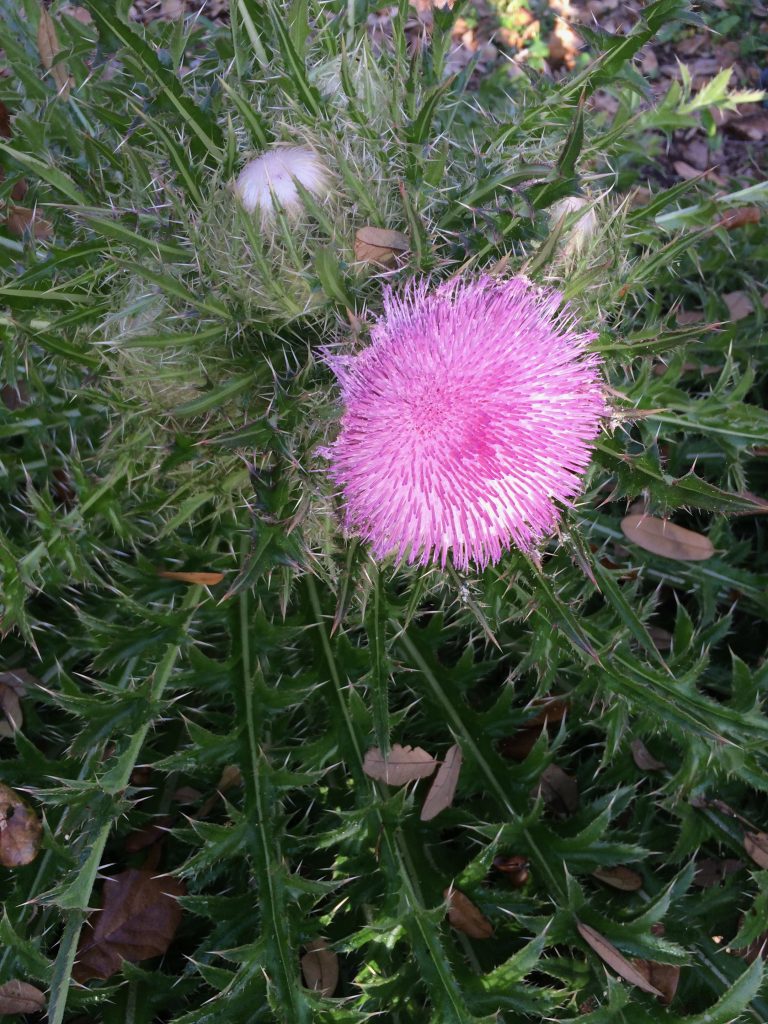
Cirsium vulgare, the Bull Thistle, looks similar to the Nuttall’s Thistle. They grow to similar heights and have prickly stems. The Bull Thistle also has white to purple to pale lavender upright blossoms but they are spiny and solitary, NOT in clusters. In both species the blossom resembles a shaving brush. Bull Thistle leaves are larger and more spiny than Nuttall’s Thistle and have prickly hairs on the upper surface. To read more about true thistles go here.
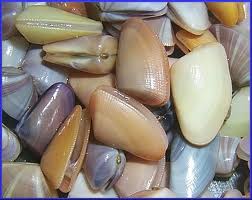
Sometime instead finding answers they find you. As you know there are several articles on the EatTheWeeds website that are about edibles covered by the subtitle: And other things, too. That subtitle was intentionally added when the site went up more than a fifteen years ago. There are a lot of things in the world to eat. Before Andrew Zimmern was traipsing around the globe for the Travel Channel eating untraditional food EatTheWeeds was writing about them. As one might expect that has caused a good amount of disagreeing mail. Many people keep as pets creatures that others eat. Thus far, however, no one has complained about Coquina, a coastal clam that’s about the size of your fingernail. The tiny clams make an absolutely delicious green broth that I like to add — I know it’s sacrilege — instant potatoes and butter. One of the down sides is that the clams are so small getting the meat out of the shell is microscopic work. That is so frustrating most of it is tossed away. However in Australia they have devised a commercial way of separating the meat and shell. How that was done was something of a mystery until a post on the Green Deane Forum. The cooked shells are vigorously stired. After that it is a matter of straining the shells from the meat. You can read about Coquina here, and crunchy Mole Crabs, here.
The endings of botanical names in Dead Latin can often give us a clue about the species especially -ifera and -oides (and variations such as -iferum.) Often the botanical name is virtually no help in identifying a plant, such as when the genus and the species honor two different people. A good example is Decaisne
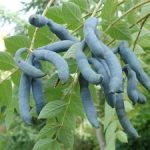
fargesii, Dead Man’s Fingers. It’s named after Joseph Decaisne and Pere Farges. No description there… seems like a lost opportunity to me… Sometimes the species name is misleading as the Longleaf Pine, Pinus palustris, which means a pine that likes to grow in swamps. Unfortunately Pinus palustris only grows on the top of dry sandy hills. That the descriptive name is very wrong is not enough to get it changed. The reason to change a name has to be botanical even if flimsy botanical.
-ifera and -oides however usually are helpful. -ifera means “producing” or “bearing.” Papyrifera means paper bearing, as in Betula papyrifera, the Paper Birch, left. Bulbifera means bulb bearing, such as the Dioscorea bulbifera, the Air Potato. Cerifera means wax bearing like the Southern Wax Myrtle, Myrica cerifera. Myrica cerifera produces a green wax that was traditionally used to make Bayberry Candles.
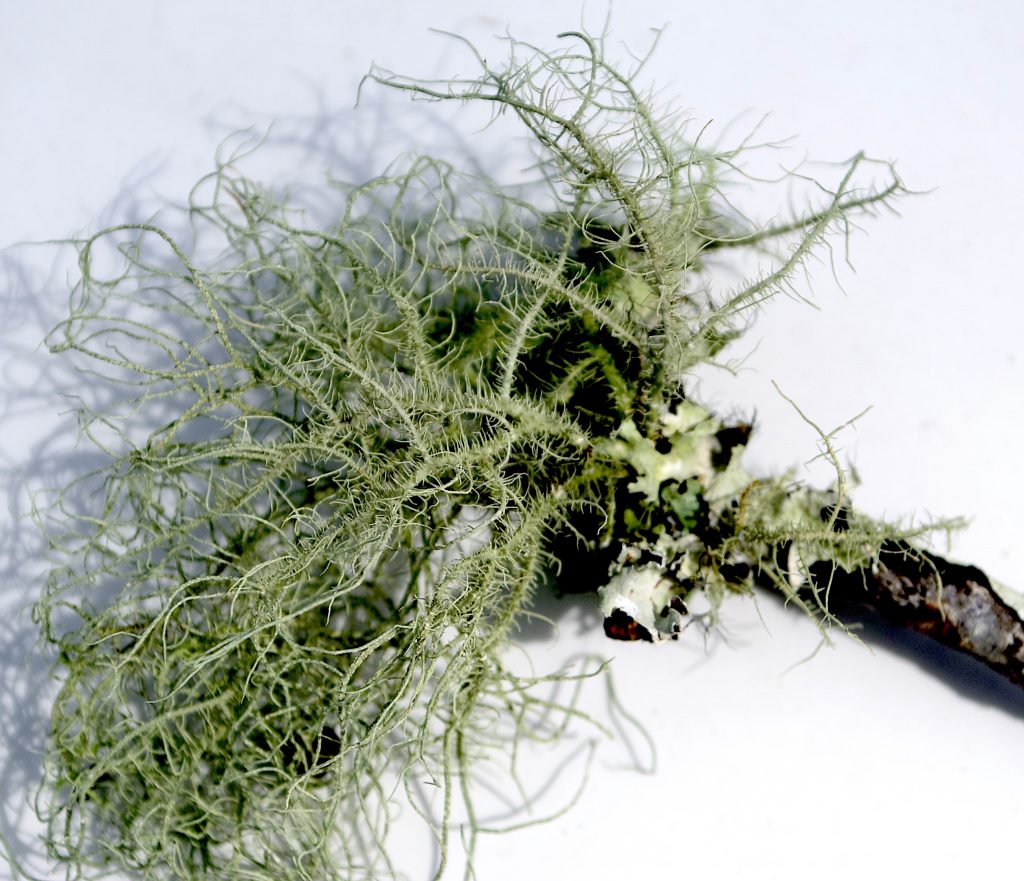
-oides means “resembling” or ‘looks like.”Tillandsia usneoides (Spanish Moss) means looks like the lichen Usnea. Ranunculoides means looks like ranunculus (Buttercups.) Centruroides means … like sharp (and is also the genus of scorpions in reference to their stingers.) While the -folia can mean leaves it is also used to mean looks like. Aquifolium means holly-like leaves. Tiliifolia — yes four “i’s” — means basswood-like leaves. Sonchifolia means leaves like a sow thistle. So if you have an -ifera in front of you it should be producing something. If you have an -oides it should look like something else you probably already know. -Folia is usually also descriptive.

I’m on the east coast this week, at a productive but civilized college campus in Jacksonville on Saturday and then the uncivilized rough-cut nature of Haulover Canal Sunday (don’t forget the time change. Be there 9 a.m. DST.)
Saturday, March 9th, Florida State College, south campus, 11901 Beach Blvd., Jacksonville, 32246. 9 a.m. to noon. We will meet at building “D” next to the administration parking lot.
Sunday, March 10th, Haulover Canal, Merritt Island National Refuge, north of the Kennedy Space Center, 9 a.m. to noon or later. Because of its shape this class requires the most walking and climbing, about four miles. We meet at the end of the northwest jetty/dirt road. Take the time change into account that day so you are on time.
Saturday March 16th, Wickham Park: 2500 Parkway Drive, Melbourne, FL 32935-2335. 9 a.m. to noon. Meet at the “dog park” inside the park.
Sunday, March 17th, Red Bug Slough Preserve, 5200 Beneva Road, Sarasota, FL, 34233. 9 a.m. to noon.
Saturday, March 23rd, Blanchard Park, 10501 Jay Blanchard Trail, Orlando, FL 32817. Meet near the tennis court near the YMCA building. 9 a.m. to noon.
Sunday, March 24th, Bayshore Live Oak Park, Bayshore Drive. Port Charlotte. 9 a.m. to noon. Meet at the parking lot at the intersection of Bayshore Road and Ganyard Street.
For more information on classes or to sign up go here.

Want to identify a plant? Looking for a foraging reference? Do you have a UFO, an Unidentified Flowering Object you want identified? On the Green Deane Forum we chat about foraging all year. And it’s not just about warm-weather plants or just North American flora. Many nations around the world share common weeds so there’s a lot to talk about. There’s also more than weeds. The reference section has information for foraging around the world. There are also articles on food preservation, and forgotten skills from making bows to fermenting food. One special section is “From the Frightening Mail Bag” where we learn from people who eat first then ask questions later. You can join the forum by clicking on “forum” in the menu.

All My Videos are available for free on You Tube. They do have ads on them so every time you watch a Green Deane video I get a quarter of one cent. Four views, one cent. Not exactly a large money-maker but it helps pays for this newsletter. If you want to see the videos without ads and some in slightly better quality you can order the DVD set. It is nine DVDs with 15 videos on each for a total of 135 videos. Many people want their own copy of the videos or they have a slow service and its easier to order then to watch them on-line. The DVDs make a good gift for that forager you know especially on long, cold winter months. Individual DVDs can also be ordered or you can pick and choose. You can order them by clicking on the button on the top right hand side of this page (if your window is open wide enough.) Or you can go here.

Donations to upgrade EatTheWeeds.com have gone well. Thank you to all who have contributed to either via the Go Fund Me link, the PayPal donation link or by writing to Green Deane POB 941793 Maitland FL, 32794. There are many needs left such as expanding the foraging teacher page and the page on monotypic edibles. I’m still having a hard time finding articles I wrote! There’s always something and such things get more complex and expensive every year. Indeed, the average email cost to send each newsletter is $20.
If you would like to donate to Eat The Weeds please click here. Or you can use my Go Fund Me link, or by writing to Green Deane POB 941793 Maitland FL, 32794
This is weekly issue 345.



Disappointingly, you did not tell how to manage the stickers before eating/cooking.
As a child in rural east central Alabama, my father would pick the thistle flowers for me, use his knife to strip the off stickers, and give them to me to tickle myself or pretend shave. The razor part did not appeal to me, only the soft brush.